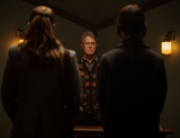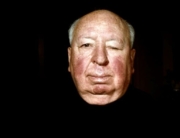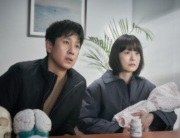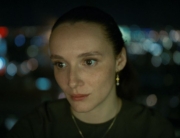Erkhmee (Erkhembayar Ganbat) and Selenge (Selenge Chadraabal) are a young Mongolian couple who rent a house deep in the snow-ridden countryside. Both are taciturn and quiet, and you can feel something is off. So can their gregarious next door (and only) neighbor. That unsettling feeling becomes somewhat clear as the controlling Erkhmee insists on Selenge taking her medication and demands that she eats. Selenge appears to be an artist, and Erkhmee has taken care to set up a studio for her, but when she enters the room, she is startled by a crow in the window—the first jump scare—and breaks a vase. Lots of ominous music and Erkhmee’s glares ensue. Right off the bat, though, you may figure out this storyline is a red herring, of which there will be many more, as well as switchbacks and an unreliable point of view in this twisty film.
The beginning is quite jumpy and arty, relying on odd camera angles, flashy cinematography, overly saturated colors, and sometimes an intrusive score. It’s all ultimately unnecessary because debut director Baatar Batsukh ends up making a solid, psychological horror film that offers surprises, even though the premise falls apart if you think about it for a half a second.
Initially, Erkhmee and Selenge barely interact, and when they do, their behavior is stiff and awkward. (Selenge is alternately passive and defiant.) It is only when the first reveal, one of many, explains why, that viewers see the two in a warmer light. The other characters are Selenge’s doctor, her two friends who visit, and the nosy neighbor. Everyone acquits themselves nicely, but special praise has to be given to Yalalt Namsrai as the neighbor. He managed to be funny, charismatic, vulnerable, and then…well, something else entirely.
Aberrance feels a bit overstuffed, overly flashy, and a tad too full of itself, but it is also intriguing, surprising, and confident. It is a fun watch and augurs a promising start to Batsukh’s career as a director.







Leave A Comment